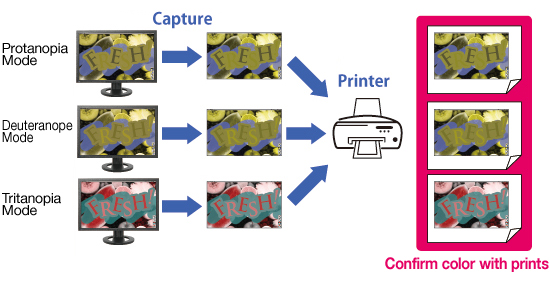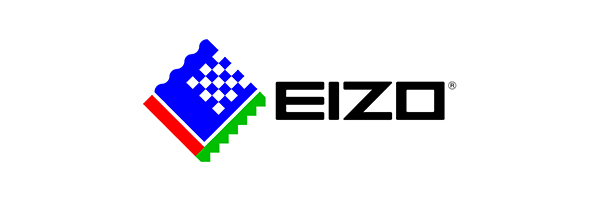ColorEdge
UniColor Pro ― About Unicolor Pro
| About UniColor Pro |
What is Color Universal Design? |
Color Universal Design in Practice |
Simulating Color Blindness |
About Unicolor Pro
|
|
EIZO's UniColor Pro software simulates color blindness when used with select EIZO LCD monitors. It allows designers to see how their printed materials, signs, web contents, videos, etc. will appear to those with color blindness. |
Color Universal Design Support
UniColor Pro supports color universal design by simulating color blindness in real time.
Not everybody views color in the same way. Certain colors are perceived differently by people with color blindness so it is important to take into account different types of color vision when choosing colors for any type of design. This is called "color universal design" and applies to the use of colors in newspapers and other printed materials, signs for public facilities, maps, and other mediums where color is used to convey information.
Color Vision Deficiency Simulation in Real Time
UniColor Pro and specific EIZO monitors present a hardware-based solution so they change how content is displayed on screen in real time without affecting the data itself. They simulate two types of red-green color vision deficiency (protanopia and deuteranopia) and one type of blue-yellow color deficiency (tritanopia). An EIZO-developed ASIC (application specific integrated circuit) inside the monitors does all the color conversion processing in real time - even moving and blinking images. With UniColor Pro software you can instantly switch among four modes - Original, Protanopia, Deuteranopia, and Tritanopia. In addition, you can capture images and print them out for comparison.
In developing the monitors, EIZO worked closely with the non-profit Color Universal Design Organization (CUDO) based in Tokyo, Japan, to conduct experiments with colorblind test subjects to improve the ability to identify difficult to distinguish colors.

Hardware vs. Software Simulation
There are two ways to simulate colors. The first is to use software to perform image editing/manipulation on the data itself, and the second is to use hardware that changes how color appears on the monitor's screen.
|
|
The main difference between these two methods is the amount of time required. In one experiment, the time needed to check the content of a web page about 11,000 pixels in length using software was 581 seconds. Using select EIZO ColorEdge monitors, a hardware solution, the same check took only 44 seconds or 1/13 the amount of time*. |
Screen Capture for Increased Efficiency
You can capture an image when any of UniColor Pro's simulation modes are active. You print them out and compare the differences.

Download UniColor Pro
You can capture an image when any of UniColor Pro's simulation modes are active. You print them out and compare the differences.
Notes on Simulations
The following points should be noted when using the monitors to view images converted through the simulation process.
(1) In the simulation of protanopes and deuteranopes, the vision of the most strongly affected people is reproduced. Approximately one third of colorblind people are estimated to be in this category. The remaining two thirds have their color vision somewhere between that and the common-type color vision, including those whose vision is very similar to the common-type vision. For this reason, please keep in mind that not all colorblind people, including those more weakly affected, have color vision as indicated in the converted images.
(2) When there is a color that is difficult to distinguish, people judge it by using information other than the actual color as a complement. For example, we view an apple as red and paper as white, even when both are lit in red under a red light. The same applies to colorblind people. For them, it is difficult to distinguish some tones of sky blue from some tones of pink. In this case, colorblind people view that the clothes worn by a man should be sky blue (even if pink), and those worn by a woman pink (even if sky blue). This happens because people judge colors by comparing them with their memories and experiences - men often wear sky blue while women wear pink.
In a color vision simulation, a range of colors that are difficult for colorblind people to distinguish are all converted into one color, which is determined by a calculation formula of the colorblind theory. Therefore, the color displayed is not necessarily the color recognized by colorblind people. For example, pink and sky blue, as described above, both appear as sky blue in simulations, but it is incorrect to think that "colorblind people see pink as sky blue."
Simulations do not show you "which color colorblind people see as a certain color." Therefore, they should only be used to understand "which colors on the screen are difficult for them to judge".
The above "Notes on Simulations" is excerpted from EIZO's "Color Universal Design Handbook" which is based on material issued by the Color Universal Design Organization (CUDO), a non-profit organization in Tokyo, Japan.
- 581 seconds was the time required to do screen captures and make image files (17 in total) for the entire web page, convert each image with the simulation software, and view the files. With the monitors, color conversion of the web page was instantaneous; 44 seconds was the time required to scroll down the web page after conversion. This example is meant to illustrate the practicality of the monitos compared to software solutions for high volume content that designers work with on a daily basis. It was taken from "Developing a Monitor for Checking Color Barrier-Free" from the collection of papers of the 31st Sensory Substitution Symposium held in Tokyo, Japan on December 5-6 2005.












